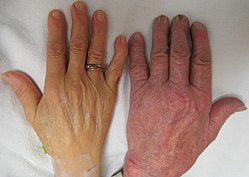Thalassaemia
Thalassaemia (or thalassemia) is a genetic disorder of the blood which originated in the Mediterranean region.
| Thalassaemia | |
|---|---|
| Classification and external resources | |
| ICD-10 | D56. |
| ICD-9 | 282.4 |
| MedlinePlus | 000587 |
| eMedicine | ped/2229 radio/686 |
| MeSH | D013789 |
Causes
This disease is caused by the weakening and destruction of red blood cells. This is caused by mutant genes which affect how the body makes hemoglobin. Haemoglobin is the protein in red blood cells which carries oxygen. Those with thalassaemia make less haemoglobin and fewer circulating red blood cells than normal, which results in mild or severe anemia.
Genetics
Carriers are heterozygous for the thalassaemia allele, meaning only one of their two alleles is mutant. There are a number of different versions of thalassaemia. Each one is caused by a mutation in a different position in the genome. In that respect, thalassaemia resembles another genetic disorder affecting haemoglobin, sickle-cell disease.[1][2]
Complications
Thalassaemia can cause significant complications, including pneumonia, iron overload, bone deformities and cardiovascular illness. However, this inherited disease of red blood cells gives a degree of protection against malaria, which is or was common in the regions where the trait is common. This selective survival advantage for carriers (known as heterozygous advantage) is responsible for keeping the mutation in populations way above its mutation rate.
Treatment
It is possible to cure patients with thalassaemia with bone marrow transplants from compatible donors.[3] However, this method requires an HLA-matched compatible donor.[4]
Thalassaemia Media
An image from a peripheral blood smear demonstrating microcytic, hypochromic red blood cells in thalassemia (50X oil immersion). An eosinophil, small lymphocyte, platelets and monocyte are also present.
References
- ↑ Weatherall David J, Chapter 47. The Thalassemias: disorders of globin synthesis. In Lichtman MA et al. Williams Hematology. 8th ed. [1] Archived 2013-11-04 at the Wayback Machine
- ↑ Mayo Clinic. [2]
- ↑ HLA-matched sibling bone marrow transplantation for β-thalassemia major, Blood Journal, 3 February 2011
- ↑ HLA = Human leukocyte antigen, a key part of the immune system.




